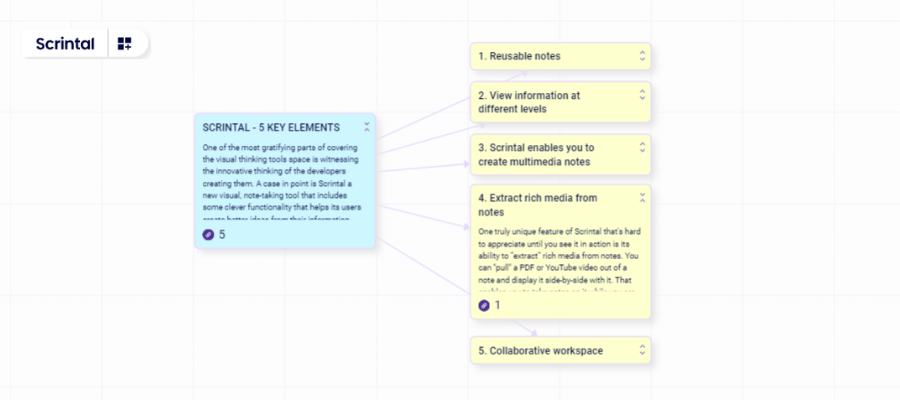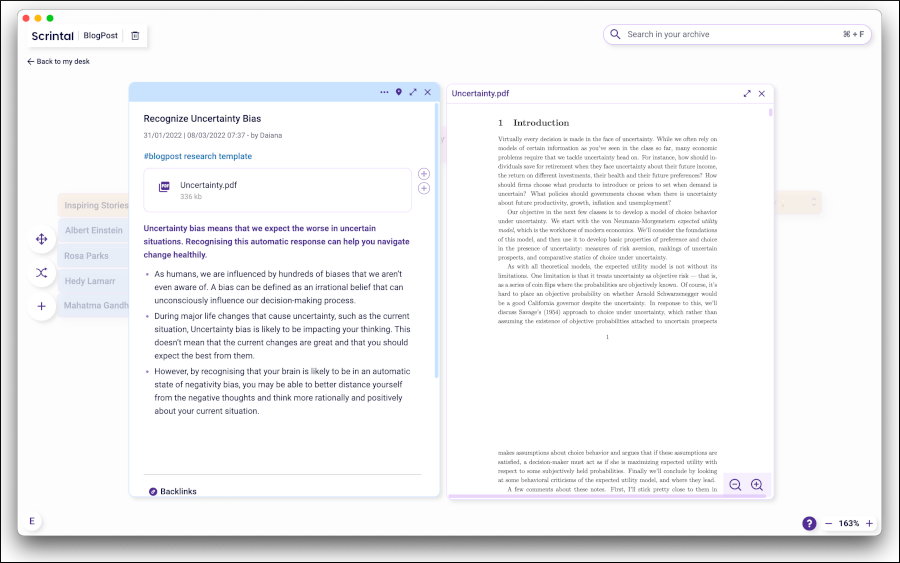
One of the most gratifying parts of covering the visual thinking tools space is witnessing the innovative thinking of the developers creating them. A case in point is Scrintal, a new visual note-taking tool that includes some clever functionality. It helps users create better ideas from their information, knowledge and ideas – AND get work done.
Here are five notable features of Scrintal that are worth a closer look:
1. Reusable notes
Most note-taking tools treat individual notes as discrete objects that only exist once in the database. Scrintal takes a much different approach:
All notes are stored in a single, searchable repository. They can be searched by keywords or tags and can be dragged and dropped into projects within the workspace. That means the same note can appear in different contexts in different projects.
Compare that to a single note in a traditional digital note-taking app: It exists once and has limited ability to be connected to or viewed in relationship with other notes. Content within your notes can be re-used, but it’s a copy-and-paste operation.
In contrast, Scrintal’s approach is simple and intuitive and helps you keep a creative “flow” going when you’re harvesting resources from your repository. Plus, the ability to re-use notes means they’re not trapped in a single context or in a project folder. They’re available for use and further nurturing at any time.
2. View information at different levels
You can not only view your notes in Scrintal at a standard rectangular size. You can also collapse them to save space, or expand them to fill the workspace – ideal if you want to capture extended thoughts without distractions.
Scrintal also enables you to join topics like a mind map, insert tables to contain structured information and create kanban boards to track the progress of your tasks.
In other words, Scrintal gives you multiple options together, organize, distill and share your best ideas. It enables you to work in the way that’s most comfortable to you, without getting in the way of your thoughts. That’s a big plus in my book.
3. Scrintal enables you to create multimedia notes
In Scrintal, notes are far more than collections of words scattered on a virtual corkboard. Each note can contain a myriad of rich media, from videos and tweets to images and PDFs.
Traditional note-taking tools vary in their support for rich media. Scrintal supports it natively and intuitively. Having access to multimedia content in your notes will undoubtedly help you generate higher-value ideas. Better raw materials usually lead to better output!
4. Extract rich media from notes
One truly unique feature of Scrintal that’s hard to appreciate until you see it in action is its ability to “extract“ rich media from notes. You can “pull” a PDF or YouTube video out of a note and display it side-by-side with it. That enables you to take notes on it while you are viewing it. Cool!
5. Collaborative workspace
The four elements of innovation are ideation, implementation, value creation and collaboration. Getting insights from other people can help you improve your ideas or look at your challenges through a different lens. Scrintal supports live collaborative editing as well as sharing notes and boards with your team members.
Most traditional note-taking apps are solitary tools, with little or no support for collaboration. Sharing, yes. Collaboration, not so much. It’s a core feature of Scrintal.
Scrintal in action: Planning a complex project
Scrintal has a stronger project orientation than other note-taking tools. Its flexible canvas and note repository make it easy to brainstorm a project by creating and manipulating multiple notes, each containing as much detail as you need.
Scrintal’s virtual canvas ensures the steady flow of creativity without interruptions. Connections rise to the surface more easily in a visual format and are not at risk of being forgotten or overlooked. You can easily link them into sequences and hierarchies and distill them into clear, concise, visual plans.
The best way to understand this flexible, visual approach is by example. Let’s say that you’ve been asked to give a speech. You know what the general topic is, but you need to figure out what, specifically, you’re going to talk about, how to support your key points, and how to create a cohesive, compelling flow of ideas and insights. A tall order!
Scrintal enables you to capture your main topic and a few related topics as a starting point. Next, you search your repository for related notes and ideas. You’re speaking on a topic that you’re passionate about, so it contains a wealth of relevant information, insights and stories. You drag and drop them into your workspace.
Now that you have a critical mass of ideas in your workspace, you move them around, gathering them into related clusters. You then connect them to form a mind map. Seeing your ideas coalesce into a solid structure gives you added creative momentum.
Now that you’ve organized your initial thoughts and resources, you can see gaps in them. So you open a browser tab and conduct some research. You discover some compelling bits and pieces from several new-to-you subject matter experts. You drag and drop them into your outline.
You also eliminate several notes that no longer fit into the structure of your presentation. They aren’t deleted from your repository; they’re just no longer part of your current project.
Finally, you search Unsplash.com for some eye-catching visuals to add to your presentation. You drag and drop them into your Scrintal workspace along with their source URLs. That will make it easy to assemble your presentation in PowerPoint.
Soon, you have a complete, well-thought-out narrative and visuals for a compelling presentation, in a fraction of the time you expected. Congratulations!
Conclusion
Scrintal is more than just a personal knowledge management tool. It’s designed to help you think better AND efficiently transform your ideas into action. If you haven’t checked it out, I highly recommend that you do so.
Click here to learn more about Scrintal or sign up now to access the public beta.



Leave a Reply